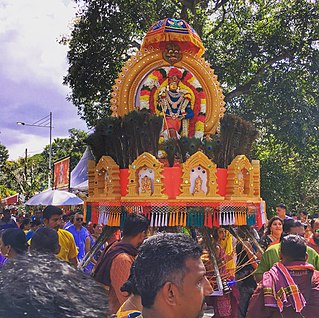
Thaipusam or Thaipoosam is a Tamil Hindu festival celebrated on the first full moon day of the Tamil month of Thai coinciding with Pusam star. The festival is celebrated to commemorate the victory of Hindu god Murugan over the demon Surapadman. During the battle, Murugan is believed to have wielded a vel, a divine spear granted by his mother, Parvati.

Kartika Deepam is a festival of lights that is observed mainly by Hindu Tamils, and also by adherents in the regions of Kerala, Andhra Pradesh, Telangana, Karnataka, and Sri Lanka. Celebrated in Tamilakam and Sri Lanka since the ancient period, the festival is held on the full moon day of the Kartika (கார்த்திகை) month, called the Kartika Pournami, falling on the Gregorian months of November or December. It is marked on the day the full moon is in conjunction with the constellation of Kartika. It corresponds to the occasion of the Kartika Purnima, though it falls on a different day due to the correction of equinoxes in the Tamil calendar.

The Arulmigu Subramanya Swami Temple, Tiruchendur is an ancient Hindu temple dedicated to Murugan (Kartikeya). It is second among six abodes of Murugan situated in Tamil Nadu, India. It is located in the eastern end of the town Tiruchendur in the district of Thoothukudi, Tamil Nadu, India. It is 40 km from Thoothukudi, 60 km south-east of Tirunelveli and 75 km north-east of Kanyakumari. The temple complex is on the shores of Bay of Bengal.

The Vayalur Murugan Temple is a Hindu temple dedicated to Muruga, son of Lord Shiva and Parvati, located in the village of Kumaravayalur in Tiruchirapalli district, Tamil Nadu, India. The temple is believed to have been initiated during the period of Medieval Cholas during the 9th century. The temple is maintained and administered by the Hindu Religious and Charitable Endowments Department of the Government of Tamil Nadu. Though the presiding deity is Shiva, the temple is known for the Murugan shrine. The temple is associated with Hindu savant, Kirupanandha Variyar.

Arulmigu Murugan Temple, Thiruparankundram is a Hindu temple dedicated to the god Murugan at Thiruparankundram, Tamilnadu, India. It is regarded as one of the "First Houses of Murugan". The temple uses rock-cut architecture and is believed to have been built by the Pandyas during the 6th century. According to legend, Murugan slayed the demon Surapadman and married his consort Devasena at the temple. Murugan is also said to have worshipped his father Shiva at the site as Parangirinathar.

The Swaminatha Swamy Temple is a Hindu temple dedicated to god Murugan. It is located in Swamimalai, 5 km from Kumbakonam, on the banks of a tributary of river Kaveri in Thanjavur District, 290 km from Chennai, the capital of Tamil Nadu, India. The temple is fourth abode of Murugan among six (Arupadaiveedugal). The shrine of the presiding deity, Swaminathaswamy is located atop a 60 ft (18 m) hillock and the shrine of his mother Meenakshi (Parvati) and father Shiva (Sundareswarar) is located downhill. The temple has three gopuram, three precincts and sixty steps and each one is named after the sixty Tamil years. The temple has six daily rituals at various times from 5:30 a.m. to 9 p.m., and three yearly festivals on its calendar. The annual Vaikasi Visagam festival is attended by thousands of devotees from far and near.
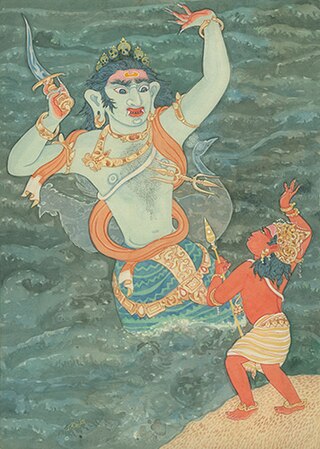
Surapadma, Surapadman or Sooran is an asura featured in Hindu literature. He is the son of the sage Kashyapa and a shakti named Maya. He wages war against the devas by invading Devaloka with a massive army. He is defeated by Murugan, and according to Tamil tradition, turned into his vahana, the peacock. He is the brother of Tarakasura. His eldest son is Banukopan.
Alvai or Alvaay is a coastal village in Vadamaraadchi, northern Jaffna Peninsula, Sri Lanka. It is located 30 kilometers (19 mi) from the city of Jaffna or 5 kilometers (3.1 mi) from the town of Point Pedro.
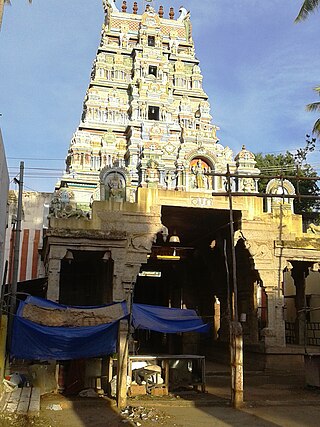
The Thirumohoor Kalamegaperumal Temple is a Hindu temple near Melur, Madurai district in the South Indian state of Tamil Nadu, is dedicated to the Hindu god Vishnu. Constructed in the Dravidian style of architecture, the temple is glorified in the Nalayira Divya Prabandham, the early medieval Tamil canon of the Alvar saints from the 6th–9th centuries CE. It is one of the 108 Divya Desams dedicated to Vishnu, who is worshipped as Kalamega Perumal and his consort Lakshmi as Mohanavalli Thayar. As per Hindu legend, the presiding deity is believed to have appeared as the divine enchantress Mohini to allure the asuras to support the devas, the celestial deities. The temple is also known as Mohanapuram and Mohanakshetram.
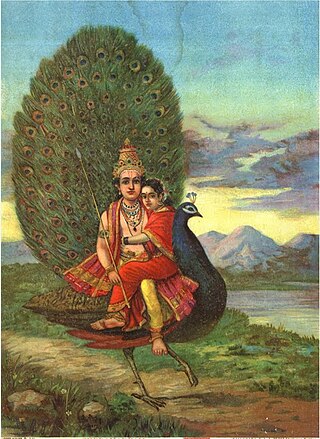
Devasena is a Hindu goddess of aspiration, and the consort of the war god Kartikeya (Murugan). She is also known as Devayanai, Deivanai, and Deivayanai in Tamil texts. Her name is also spelled as Teyvanai or Tevayanai.
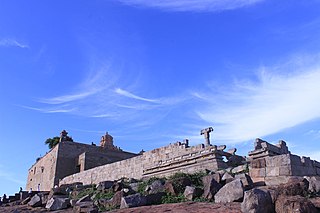
Erumbeeswarar Temple in Thiruverumbur, Tamil Nadu, India, is a Hindu temple dedicated to the deity Shiva. Built on a 60-foot (18 m) tall hill, it is accessible via a flight of steps. The temple's main shrines and its two prakarams are on top of the hill, while a hall and the temple tank are located at the foothills. Shiva is believed to have transformed himself into an ant hill and tilted his head at this place to enable ants to climb up and worship him. Erumbeeswarar is revered in the canonical 7th-century Tamil Saiva work the Tevaram, written by Tamil saint poets known as nayanmars and classified as Paadal Petra Sthalam.

The Six Abodes of Murugan are six temples situated in the state of Tamil Nadu in South India, dedicated to the Hindu deity Murugan. These six sacred abodes of Murugan are mentioned in Tamil Sangam literature, in the texts of Tirumurukāṟṟuppaṭai, written by Nakkīraṉãr, and in Tiruppukaḻ, written by Arunagirinathar. The six abodes are Thiruparankundram, Tiruchendur, Palani, Swamimalai, Tiruttani, and Pazhamudircholai.
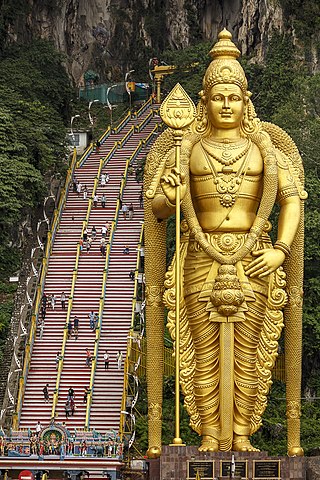
Kaumaram is a Hindu denomination that primarily venerates the Hindu deity of war, Kartikeya, also known as Kumaran, Murugan, Arumugan, and Subrahmanyan. Devotees of Kumaran, called Kaumaras, also revere members of his family: Parvati, Shiva, and Ganesha, as well his consorts, Devasena and Sundaravalli, the daughters of Vishnu in Tamil tradition. The important theological texts relating to Kumara are a part of the Shaiva agama canon. This sub-tradition is found among the Tamils, Kannadigas, and the Vedda, in South India, Sri Lanka, and among the Tamil diaspora worldwide. The love story of Kumara/Murugan and his wife Valli, a girl from a local tribe, is popular in Tamil Nadu, where Kumara acquired the status of a national god.
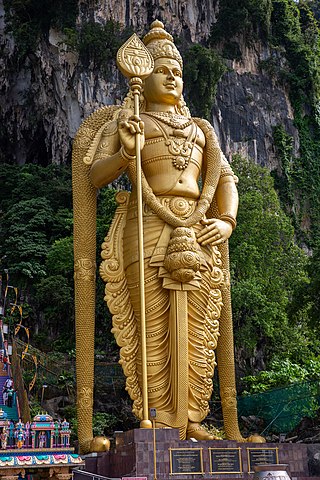
Kartikeya, also known as Skanda, Subrahmanya, Shanmukha and Murugan, is the Hindu god of war. He is generally described as the son of the deities Shiva and Parvati and the brother of Ganesha.

Velanai Island, also known as Leiden in Dutch, is a small island off the coast of Jaffna Peninsula in the north of Sri Lanka. There are number of villages within the island, such as Allaipiddy, Mankumpan, Velanai, Saravanai, Puliyankoodal, Suruvil, Naranthanai and Karampon.

The cock flag is the flag of the Hindu deity Kartikeya, also rendered Skanda, and Murugan in Tamil tradition. The deity Murugan is depicted with the divine spear vel in one hand and the cock flag in the other in his iconography.

Kalugasalamoorthy Temple in Kalugumalai, a panchayat town in Thoothukudi district in the South Indian state of Tamil Nadu, is dedicated to the Hindu god Murugan. Constructed in the Dravidian style of architecture, the temple is believed to have been expanded during the 18th century with the images excavated from Kalugumalai. The core temple has a rock-cut architecture exemplary of early Pandyan Art. The other portions of Kalugumalai houses the 8th century Kalugumalai Jain Beds and Vettuvan Koil, an unfinished Shiva temple.
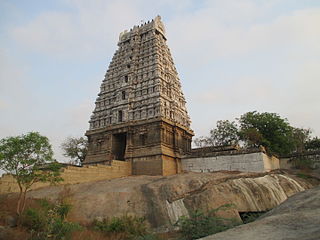
Atulya Nadheswarar Temple is a Hindu temple dedicated to the deity Shiva, located in Arakandanallur in Thirukoilur taluk, a town panchayat in Viluppuram district in the South Indian state of Tamil Nadu. Shiva is worshipped as Atulya Nadheswarar, and is represented by the lingam. His consort Parvati is depicted as Azhagiya Ponnazhagi. The presiding deity is revered in the 7th century Tamil Saiva canonical work, the Tevaram, written by Tamil saint poets known as the Nayanars and classified as Paadal Petra Sthalam.
The Shashti Vrata is a Hindu observance. It is primarily observed by South Indian Hindus during the month of Ashvina, from the first day after the new moon until the sixth day. Adherents fast for six days continuously in order to receive the blessings of the deity Murugan. Shashti Vrata is also prescribed for the worship of Surya in some texts.

Tamil Kadavul Murugan is a 2017 Tamil-language mythology soap opera based on the life of the Hindu deity Murugan. It began airing on 2 October 2017 on Vijay TV every Monday to Friday, replacing Bigg Boss Tamil. Season 1 ended with 104 episodes from 23 February 2018. Season 2 aired from 5 May 2018 to 19 May 2018 only on Hotstar for 15 episodes.


















